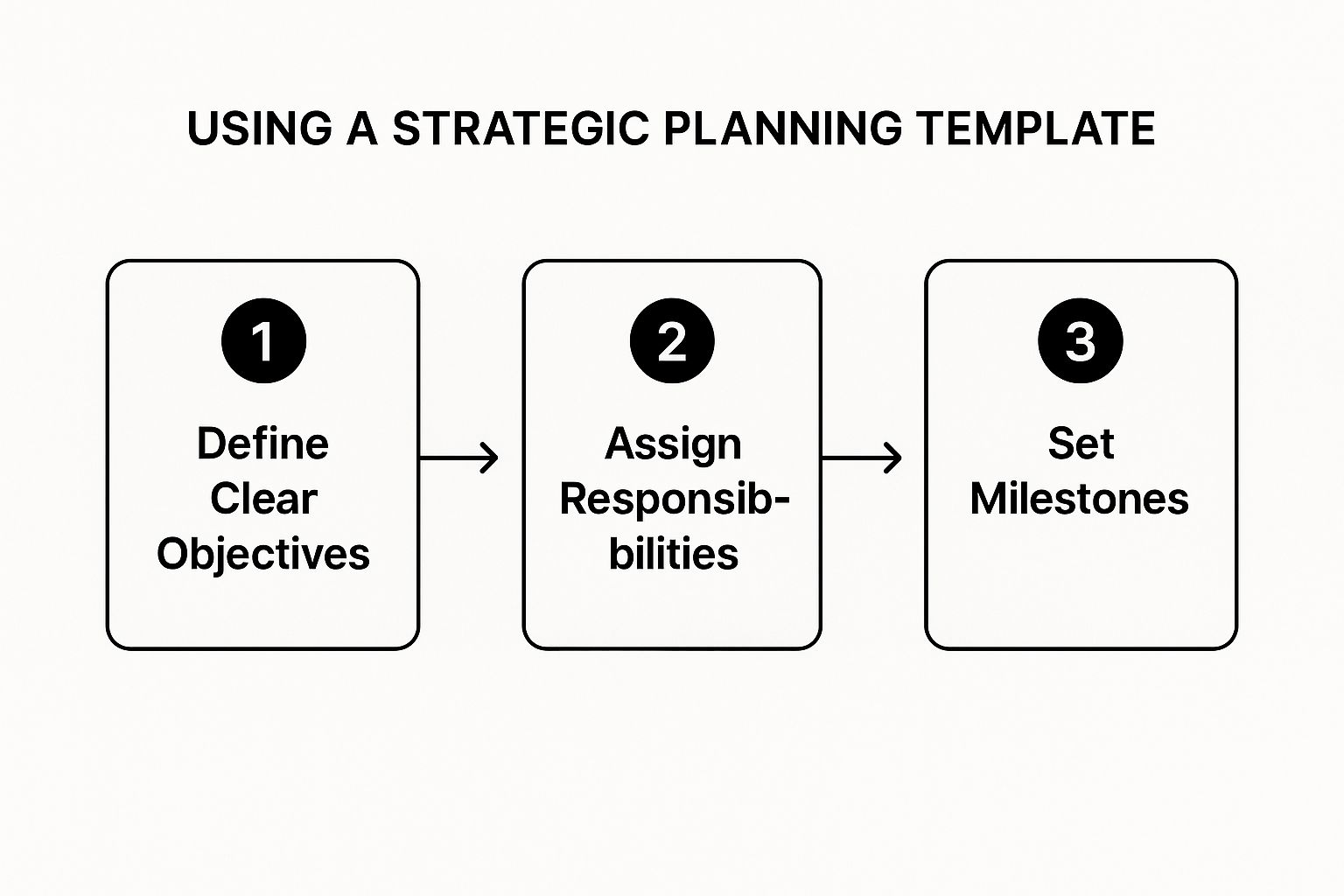Let's be real—most generic strategic planning templates are cooked up in a boardroom, far removed from the day-to-day hustle of a field sales team. They lay out a big-picture vision but completely miss the mark when it comes to the actual grind your reps face on the ground. For field sales, a plan has to be more than just a list of goals; it needs to be a practical, living roadmap for success in the trenches.
Why Generic Plans Cripple Field Sales Teams

Think about the last corporate strategic plan you saw. It was probably filled with impressive-sounding objectives that gave zero practical guidance to the rep managing a tough territory, trying to nurture key client relationships, or closing deals door-to-door.
This is exactly where those one-size-fits-all plans fall apart. A standard template might declare a company-wide goal to “increase market share by 10%,” but it won’t tell a rep in a specific region how they’re supposed to make that happen. This leaves a huge gap between the strategy dreamed up at HQ and the execution happening on the front lines.
The Dangers of a One-Size-Fits-All Approach
When a plan doesn't speak the language of field sales, it's destined to be filed away and forgotten. Generic templates just can't account for the critical details that make or break a territory.
Here are the biggest things they miss:
- Complex Territory Dynamics: Selling in a dense urban centre is a completely different ball game than covering a sprawling rural region. A generic plan often treats all territories the same, ignoring massive differences in customer density, travel time, and the local competitive scene.
- Nuanced Client Relationships: Field sales is built on trust and personal connection. A cookie-cutter template can't possibly capture the deep history with a major account or the unique pain points of a small, local business owner.
- Real-Time Market Feedback: Your reps are your eyes and ears on the ground. They’re the first to hear about a new competitor’s aggressive pricing or a sudden shift in customer preferences. A rigid plan has no way to absorb and react to this vital, real-time intelligence.
A truly effective strategic plan doesn't just set targets; it empowers your team by showing them how their daily actions directly move the needle on the company's biggest goals. It turns abstract objectives into concrete, actionable steps.
Think about it—a plan that ignores these realities is just a piece of paper. To really drive performance, your strategy needs to be grounded in the operational truths of your team. This table breaks down exactly why a field-sales-specific plan wins every time.
Field Sales Plan Essentials vs Generic Business Goals
table block not supported
A tailored approach ensures that every ounce of effort your team puts in is directly aligned with the company’s core financial and growth objectives.
For instance, we're seeing how computerized strategic planning templates are making a huge difference in operational efficiency, especially in sectors like California's retail industry. These tools provide a solid framework covering everything from situational analysis to financial resources and customer identification. This lets retailers fine-tune their operations to match market conditions by setting clear sales targets and profit margins. You can discover more about how structured planning aids retail management to see these principles in action.
Ultimately, this is about turning your team's hard work into results you can actually measure.
Building Your Plan's Strategic Foundation
Before you even think about plugging details into a strategic planning template, we need to lay the groundwork. A template is just a framework; the real magic happens when you infuse it with a solid strategy. This all starts with a clear, sales-focused mission that actually gets your team fired up.
A mission statement shouldn't just be some corporate jargon hanging on a wall. For a field sales team, it needs to be a rallying cry that gives meaning to the daily grind. So, instead of something vague like, "To be a market leader," let's get specific. How about: "To become the most trusted home services provider in the Greater Toronto Area by delivering transparent quotes and exceptional on-site service." Now that gives your reps a clear identity and a purpose every time they knock on a door.
Run a No-Nonsense SWOT Analysis
With your mission set, it's time for a reality check with a SWOT analysis. This isn't some business school exercise; it’s a boots-on-the-ground assessment of where your team stands right now. Forget the generic business buzzwords and focus on what’s really happening in the field.
A real-world SWOT for a field sales team might uncover things like this:
- Strengths: You've got an experienced rep who has deep relationships in a key downtown territory. Or maybe your team is brilliant with a mobile CRM like LeadFlow Manager, which makes capturing leads on the fly a breeze.
- Weaknesses: Your follow-up process is all over the place, letting warm leads slip through the cracks. Or perhaps you have a gaping hole in your coverage of a booming suburban area.
- Opportunities: A massive new condo development is creating a goldmine of potential customers. A local competitor just got slammed with bad online reviews, opening a door for your team to shine.
- Threats: A new player in the market is undercutting everyone with aggressive, low-ball pricing. Rising fuel costs are eating into your team's operational budget.
Getting this specific turns your SWOT from a simple checklist into a powerful diagnostic tool. It shows you exactly where you need to focus your efforts.
A SWOT analysis is only useful if it's brutally honest. Get your sales reps involved in this process. They're on the front lines and see weaknesses and threats you might miss from behind a desk.
Set Sales Objectives That Actually Mean Something (SMART Goals)
Your mission is your "why," and your SWOT tells you "where" you are. Now, you need SMART objectives to lock in your "what" and "when." Goals like "increase sales" are completely useless. To be effective, your objectives have to be tied directly to sales outcomes and defined with precision.
This chart shows how it all flows together, from defining these goals to getting things done.

As you can see, clear objectives come first. They're the bedrock of your plan, setting the stage for assigning responsibilities and tracking your progress down the line.
Here’s how you can turn a vague business goal into a sharp, SMART sales objective:
- Specific: We will increase our residential solar panel installation market share in the Peel Region.
- Measurable: The goal is to grow from 10% to 15% market share.
- Achievable: Based on our team's current capacity and lead flow, this 5% bump is a challenging but realistic stretch.
- Relevant: This directly supports our company's bigger picture goal of expanding our footprint in key suburban markets.
- Time-bound: We will hit this target within the next two quarters (by the end of Q3).
Nailing down these core elements—a sharp mission, an honest SWOT, and SMART objectives—is what transforms a blank strategic planning template into a dynamic roadmap that will actually guide your field sales team to a win.
Focusing on Metrics That Actually Drive Growth

Alright, let's have a frank conversation about what success really looks like. A packed calendar and a high call count might seem impressive on a weekly report, but honestly, those are often just vanity metrics. They show activity, not progress. The real health of your sales operation comes down to tracking the Key Performance Indicators (KPIs) that are directly tied to your bottom line.
A well-built strategic planning template is your best tool for this. It forces you to look past the busy work and zero in on the numbers that actually signal growth and profitability. For any field sales team serious about long-term success, making this shift isn't just a good idea—it's essential.
From Busy Work to Productive Work
The name of the game is measuring outcomes, not just effort. Think about it: would you rather have a rep who makes 50 cold calls a day, or one who turns 1 in every 10 demos into a signed contract? That’s the crucial difference between being active and being productive.
Let’s take an industrial equipment supplier as an example. Their strategic plan could track the "demo-to-close ratio" for every single rep. This one metric tells you so much. If a rep's ratio is way below the team average, it’s not about pointing fingers. It’s a clear signal that they need some targeted coaching. Maybe they're struggling with objection handling, or perhaps their closing technique needs a bit of polish.
Moving from vanity metrics to performance metrics is the single most powerful shift a sales manager can make. It transforms your team's focus from "looking busy" to "being effective."
When you take this data-driven approach, you eliminate the guesswork. You can see exactly where your strategies are hitting the mark and where you need to make adjustments, which gives you the confidence to pivot when necessary.
KPIs That Reveal the Full Story
To get a complete picture of your sales health, your template needs a solid mix of leading and lagging indicators. Leading indicators are your crystal ball—they help predict future success. Lagging indicators, on the other hand, show you past results. You need both.
Here are a few high-impact KPIs I always recommend building into a plan:
- Cost Per Acquisition (CPA): This tells you exactly what it costs to land each new customer. If your CPA is climbing, it might mean your lead gen efforts or territory management are becoming less efficient.
- Sales Cycle Length: How long does it take to get a lead from that first "hello" to a closed deal? Shortening this cycle is one of the quickest ways to boost revenue.
- Customer Lifetime Value (CLV): This metric is all about the long game. It helps you understand the total worth of a customer, which informs how much you should be investing to acquire and keep them.
- Lead Response Time: In field sales, speed is everything. You have to track how quickly your reps are following up on new leads. Improving this often comes down to smarter territory management and lead routing. If you want to dive deeper, we've got a great guide on lead routing best practices to boost sales efficiency.
By embedding these kinds of metrics right into your strategic plan, you create a culture of accountability and continuous improvement. Your team knows exactly what they're aiming for, and you have the clear data you need to help them get there.
Adapting Your Plan for Territories and People
A great strategic planning template is your launchpad, not the destination. I’ve seen countless sales managers make the same mistake: they roll out a single, uniform strategy for every rep and every patch of ground. This blanket approach completely misses the most important factor in your whole operation—your people and the unique markets they work in.
Think about it. Your top performer who’s absolutely crushing it in a dense, competitive urban centre needs a completely different playbook than the rep building a network from scratch across a sprawling rural territory. This is where the magic happens. Customization turns a good plan into a phenomenal one.
It’s all about shaping the strategy to fit both the landscape and the individual talents of your team. When you do this, the plan suddenly feels relevant and, most importantly, achievable. That’s how you get genuine buy-in.
Tailoring Strategies for Territory Potential
First things first, you have to stop seeing your territories as identical plots on a map. Each one has its own personality, with distinct challenges and hidden gems. To set realistic and tiered targets, you need to break them down.
- High-Growth Urban Areas: These are often packed with potential leads, but the competition is fierce. The strategy here should be all about speed, efficiency, and a high volume of quality conversations.
- Established Suburban Markets: In these areas, the game shifts. The focus is less about discovery and more about nurturing what you have—upselling existing clients and generating referrals are key. Your rep's plan should revolve around deep relationship-building and customer satisfaction.
- Developing Rural Regions: These territories demand patience. They often involve long drive times between prospects and a slower, more deliberate approach to building trust. The plan needs to account for longer sales cycles and prioritize the handful of key accounts that will make or break the year.
For instance, a rep in a bustling city might have a KPI for “new demos scheduled per week.” Meanwhile, their counterpart in a mature suburban market could be measured on “customer retention rate.” This kind of nuance is what makes the goals feel fair and actually motivating.
A plan that ignores individual differences is just a list of instructions. A plan that builds on personal strengths becomes a collaborative roadmap to success.
This is what separates a document that gets printed and forgotten from a living tool that actively drives performance. You’re building a framework that’s structured enough to provide direction but flexible enough to handle the real world. You can see how this tailored approach benefits a wide variety of field sales teams in different industries by adapting to their specific operational needs.
Integrating Personal and Professional Growth
Beyond just territory specifics, the absolute best plans weave in personal development goals for every single person on the team. This is how you show you're invested in them not just as numbers on a board, but as professionals building a career. It creates a powerful culture where everyone is aiming to get better.
So, what does that look like in practice?
- Got a new rep who’s brilliant at opening doors but struggles with closing? Their plan could include a goal to attend two advanced sales negotiation workshops this quarter.
- What about that seasoned pro who’s looking for the next challenge? You could build in a mentorship goal where they help train junior team members.
This approach proves that the strategic plan isn’t just a top-down directive; it’s a tool for mutual success. When you, as a leader, show that level of commitment, the buy-in from the team becomes automatic. By connecting the team's overarching goals to individual growth, your strategic plan becomes a living, breathing guide that everyone is genuinely motivated to follow.
Bringing Your Strategic Plan to Life

Let's be honest. A beautifully designed plan is completely useless if it just sits in a folder on your shared drive. The real measure of your strategic planning template isn't how it looks, but whether it actually gets used by your field sales team day in and day out. This is where the rubber meets the road.
The way you roll out the plan is your first real test. Don't just email a PDF and cross your fingers. That never works. You need to get everyone in a room (or on a call) and walk them through it. Explain the why behind every objective. Show each rep exactly how their daily grind—the calls, the meetings, the follow-ups—connects directly to the company's big-picture goals. When they see that link, you get buy-in. Real ownership.
This idea isn't new. Look at how the Sacramento City Unified School District approached its strategic plan. They held tons of community forums to make sure the final document wasn't just some top-down directive, but something that genuinely reflected what people needed. That kind of transparency and collaboration creates a rock-solid foundation for whatever you're trying to build.
Establishing a Rhythm for Review and Accountability
To stop your strategy from going stale after the first month, you have to build in a regular review cadence. A plan isn’t a stone tablet; it’s a living, breathing guide that needs attention. This means scheduling consistent check-ins to see what’s working, what’s not, and to celebrate the wins.
The key is finding a realistic rhythm. If you try to review everything every single week, you'll just burn your team out. I’ve found a structure that works well for balancing high-level oversight with on-the-ground agility:
- Quarterly Strategic Reviews: These are your big-picture meetings. Are we making headway on our major goals, like increasing market share or breaking into a new region? This is where you zoom out, look at the data, and make major course corrections if needed.
- Monthly KPI Check-ins: This is more tactical. Here, you're digging into the specific metrics driving those quarterly goals—things like demo-to-close ratios, average sales cycle length, or lead response times. It's your chance to spot problems early and provide coaching before they derail a whole quarter.
- Weekly Huddles: Keep these short, sweet, and informal. What roadblocks are you hitting right now? What was the big win from last week? These quick touchpoints keep everyone aligned and the momentum going.
Making Adjustments with Confidence
This regular meeting cadence creates a powerful feedback loop. It turns your strategic plan from a static document into a dynamic tool you can use to navigate the messy reality of sales. Things will always go sideways. A competitor will launch a surprise promo, customer needs will shift, or you'll lose a key person. It happens.
A great plan doesn't just outline the path to success; it builds in the agility to adapt when that path changes. It fosters a culture where data-driven adjustments are seen as a strength, not a failure.
When you have a solid review process in place, you can make these course corrections with confidence, not panic. The data from your KPI check-ins gives you the ground truth, so you're making informed decisions instead of just guessing. This is how you create a real system of accountability where the whole team is invested in turning that plan into tangible results.
If you're just starting to put these kinds of processes in place, our guide on getting started with LeadFlow Manager can show you how the right tool can make all of this much, much easier to manage.
Of course. Here is the rewritten section, following all your specific guidelines and emulating a natural, expert tone.
Field Sales Planning Questions I Hear All the Time
Even with a great strategic planning template in hand, putting it into practice is where the real work begins. Over the years, I've seen even the sharpest sales managers run into the same practical questions when they try to turn a document into results.
Let's get ahead of those common hurdles. I'll walk you through the most frequent questions I get, so you can sidestep the pitfalls from day one.
How Often Should We Actually Update Our Sales Plan?
Your strategic plan shouldn't be a "set it and forget it" document. Think of it more like a GPS—it needs to adjust to real-world conditions.
